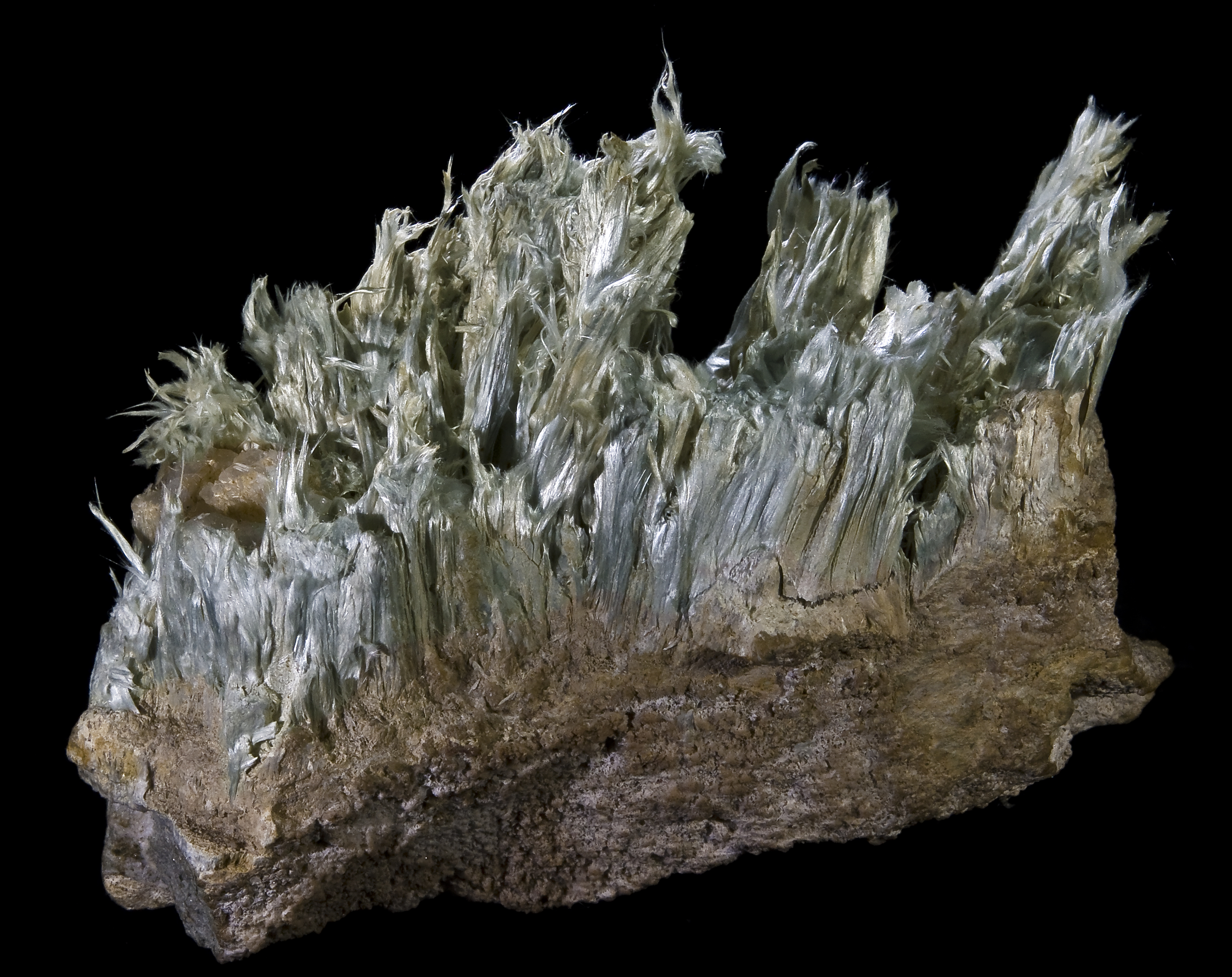Tremolite on:
[Wikipedia]
[Google]
[Amazon]
Tremolite is a member of the amphibole group of
 Tremolite is an indicator of metamorphic grade since at high temperatures it converts to diopside.
Tremolite occurs as a result of contact metamorphism of calcium and magnesium rich siliceous
Tremolite is an indicator of metamorphic grade since at high temperatures it converts to diopside.
Tremolite occurs as a result of contact metamorphism of calcium and magnesium rich siliceous
Mineral may unlock secrets of Venus's ancient oceans
New Scientist, ''10 October 2007'' Calcium minerals Magnesium minerals Asbestos Amphibole group Monoclinic minerals Minerals in space group 12 Luminescent minerals
silicate minerals
Silicate minerals are rock-forming minerals made up of silicate groups. They are the largest and most important class of minerals and make up approximately 90 percent of Earth's crust.
In mineralogy, silica (silicon dioxide, ) is usually con ...
with composition: Ca2(Mg5.0-4.5Fe2+0.0-0.5)Si8O22(OH)2. Tremolite forms by metamorphism
Metamorphism is the transformation of existing rock (the protolith) to rock with a different mineral composition or texture. Metamorphism takes place at temperatures in excess of , and often also at elevated pressure or in the presence of ch ...
of sediments rich in dolomite Dolomite may refer to:
*Dolomite (mineral), a carbonate mineral
*Dolomite (rock), also known as dolostone, a sedimentary carbonate rock
*Dolomite, Alabama, United States, an unincorporated community
*Dolomite, California, United States, an unincor ...
and quartz
Quartz is a hard, crystalline mineral composed of silica ( silicon dioxide). The atoms are linked in a continuous framework of SiO4 silicon-oxygen tetrahedra, with each oxygen being shared between two tetrahedra, giving an overall chemical f ...
. Tremolite forms a series with actinolite and ferro-actinolite. Pure magnesium
Magnesium is a chemical element with the symbol Mg and atomic number 12. It is a shiny gray metal having a low density, low melting point and high chemical reactivity. Like the other alkaline earth metals (group 2 of the periodic ...
tremolite is creamy white, but the color grades to dark green with increasing iron
Iron () is a chemical element with symbol Fe (from la, ferrum) and atomic number 26. It is a metal that belongs to the first transition series and group 8 of the periodic table. It is, by mass, the most common element on Earth, right in ...
content. It has a hardness on Mohs scale
The Mohs scale of mineral hardness () is a qualitative ordinal scale, from 1 to 10, characterizing scratch resistance of various minerals through the ability of harder material to scratch softer material.
The scale was introduced in 1812 by ...
of 5 to 6. Nephrite, one of the two minerals of the gemstone jade, is a green variety of tremolite.
The fibrous form of tremolite is one of the six recognised types of asbestos. This material is toxic, and inhaling the fibers can lead to asbestosis
Asbestosis is long-term inflammation and scarring of the lungs due to asbestos fibers. Symptoms may include shortness of breath, cough, wheezing, and chest tightness. Complications may include lung cancer, mesothelioma, and pulmonary heart ...
, lung cancer
Lung cancer, also known as lung carcinoma (since about 98–99% of all lung cancers are carcinomas), is a malignant lung tumor characterized by uncontrolled cell growth in tissues of the lung. Lung carcinomas derive from transformed, mali ...
and both pleural and peritoneal mesothelioma. Fibrous tremolite is sometimes found as a contaminant in vermiculite, chrysotile (itself a type of asbestos) and talc.
Occurrence
 Tremolite is an indicator of metamorphic grade since at high temperatures it converts to diopside.
Tremolite occurs as a result of contact metamorphism of calcium and magnesium rich siliceous
Tremolite is an indicator of metamorphic grade since at high temperatures it converts to diopside.
Tremolite occurs as a result of contact metamorphism of calcium and magnesium rich siliceous sedimentary rock
Sedimentary rocks are types of rock that are formed by the accumulation or deposition of mineral or organic particles at Earth's surface, followed by cementation. Sedimentation is the collective name for processes that cause these particles ...
s and in greenschist facies metamorphic rocks derived from ultramafic or magnesium carbonate bearing rocks. Associated minerals include calcite, dolomite Dolomite may refer to:
*Dolomite (mineral), a carbonate mineral
*Dolomite (rock), also known as dolostone, a sedimentary carbonate rock
*Dolomite, Alabama, United States, an unincorporated community
*Dolomite, California, United States, an unincor ...
, grossular, wollastonite, talc, diopside, forsterite, cummingtonite
Cummingtonite ( ) is a metamorphic amphibole with the chemical composition , magnesium iron silicate hydroxide.
Monoclinic cummingtonite is compositionally similar and polymorphic with orthorhombic anthophyllite, which is a much more common fo ...
, riebeckite and winchite
Winchite is a mineral in the amphibole group.
Name
The mineral is named after Howard James Winch, who was the one discovered it in Madhya Pradesh, India. Sir Lewis Fermor was the one who named the mineral.
Winchite is also called Aluminowin ...
.
Tremolite was first described in 1789 for an occurrence in Campolungo, Piumogna Valley, Leventina, Ticino
Ticino (), sometimes Tessin (), officially the Republic and Canton of Ticino or less formally the Canton of Ticino,, informally ''Canton Ticino'' ; lmo, Canton Tesin ; german: Kanton Tessin ; french: Canton du Tessin ; rm, Chantun dal Tessin . ...
(Tessin), Switzerland
). Swiss law does not designate a ''capital'' as such, but the federal parliament and government are installed in Bern, while other federal institutions, such as the federal courts, are in other cities (Bellinzona, Lausanne, Luzern, Neuchâtel ...
.
Fibrous tremolite
One of the six recognized types of asbestos, approximately 40,200 tons of tremolite asbestos is mined annually in India. It is otherwise found as a contaminant.See also
* Libby, Montana – location of asbestos-related ailments caused by tremoliteReferences
{{ReflistMineral may unlock secrets of Venus's ancient oceans
New Scientist, ''10 October 2007'' Calcium minerals Magnesium minerals Asbestos Amphibole group Monoclinic minerals Minerals in space group 12 Luminescent minerals